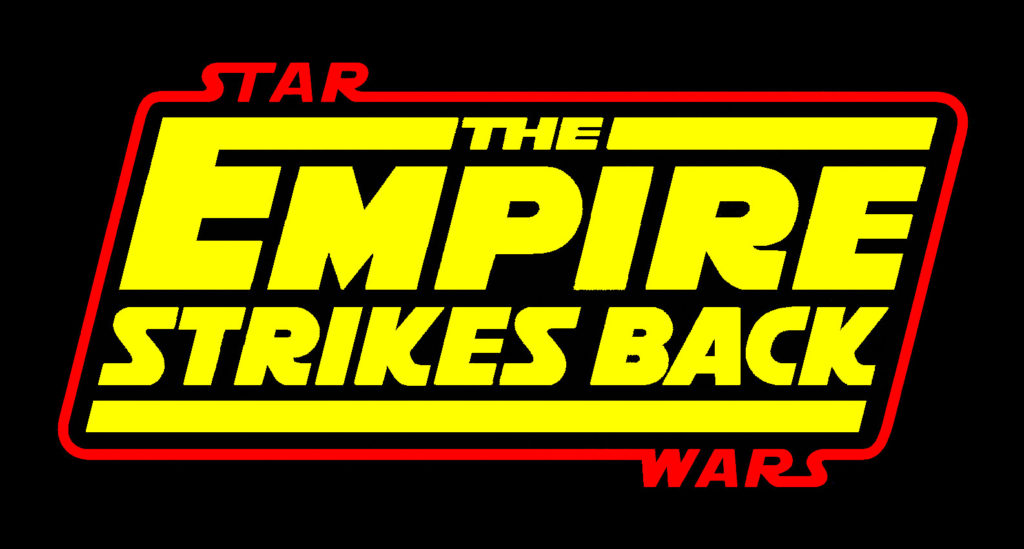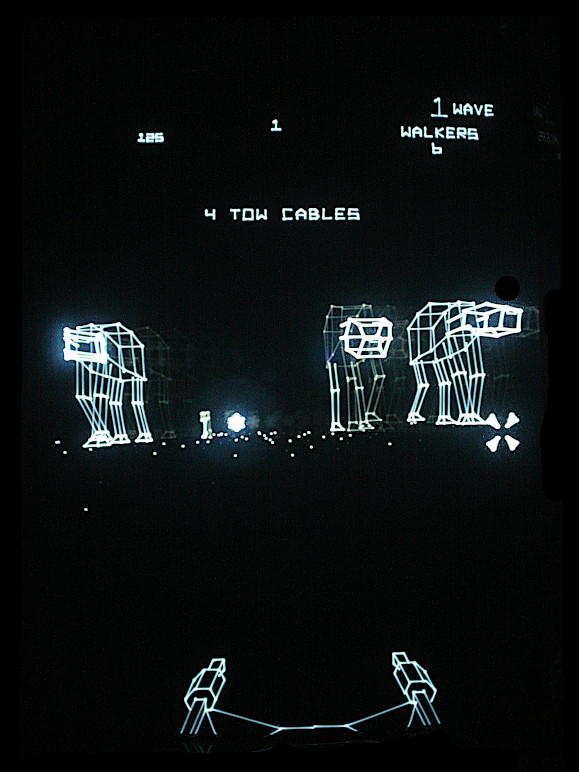VecFever documentation
Empire Strikes Back

Atari, 1985
The last arcade vector game Atari released, based on the second Star Wars movie, sadly was not using updated hardware but a naked attempt to get more money out of the very popular first Star Wars game by Atari. This was a conversion kit for the first cabinet using almost the exact same pcb setup and no one in their right mind ever converted it – or at least not for long – since the ‘upgrade’ is not the better game. Not even as good. Actually bordering on annoying, even, especially the asteroids level. The code wastes also an inordinate amount of space and cycles to prevent people from understanding and copying the roms and adapting a Star Wars cabinet on their own to the new game.
So converting this was mainly to see the Probots on the Vectrex. And the incoming walkers and shoot a tow cable at them or two. But mainly this was for completion’s sake to have all 8-bit vector arcade games as a static binary translation for myself and as a result running on the vf – and it became a larger detour into a specific technical, optimization aspect I have been using successfully anywhere else and wanted to get here, too. There is a detailed post of mine explaining this on this site:
The vector count is – even more so than the original Star Wars game – way too high for the poor Vectrex so this game flickers badly. So to cut down on the vector count there are options to draw less on the Vectrex which helps noticeably but is not enough to get a high, stable refresh rate – the game elements or absolutely necessary texts are already frequently too much to draw in one 50Hz Vectrex frame.
Inputs
The game uses analog joystick inputs, button 3: to shoot laser or tow cable depending on level and button 4: to start a game (attract) / fire (in-game)
Options
- Difficulty: Easy / Moderate / Hard / Hardest
- Graphics: Arcade / Vectrex / Vectrex+Overlay / Vectrex+Shield
- Jedi-Letter Mode: Level / Level Only / Increment / Increment Only
- Joystick: Normal / Y-Inverted
- Starting Shields: 2 / 3 / 4 / 5
- Reset Highscores
- Game Info: ” Empire Strikes Back is the very last 8-bit vector arcade game by Atari. This game is a child of the year 1985 – the arcade industry in decline, game time per coin had to be forced to be as small as possible and to make matters even worse: Atari decided not to build dedicated Empire Strikes Back cabinets but offered upgrade kits for the existing Star Wars cabinets. This decision directly affects the game in major parts: it did not allow the engineers to increase the performance of the hardware but only allowed them to use larger ROMs. And since it was feared that the game would be ‘stolen’ they used a security chip for half the bank switched ROMs. The security part was effective – there were no kits until years later – but the joke really was and still is on Atari: hardly anyone wanted to convert a perfectly nice Star Wars to an ESB… esp. after playing ESB. I think I speak for almost everyone when I say that ESB is definitely the lesser game. The underlying code in the SLAPSTIC protected ROM is also among the worst code I have yet seen, not helping any to endear me to ESB.. “
Localization
//NAME="ESB"
//
GERMAN[] = {
{ 0, 0, "Startschilde"},
{ 0, 0, "Jedi-Letter Modus"},
{ 0, 0, "Nur Level"},
{ 0, 0, "Level"},
{ 0, 0, "Nur Inkrement"},
{ 0, 0, "Inkrement"},
{ 0, 0, 0},
{ 0, 0, "Vectrex+Schild"},
{ 0, 0, 0}
{ 0, 0, "Joystick: Y-Invertiert"},
{ 0, 0, " Empire Strikes Back ist das letzte 8-Bit Vektorarcadespiel von Atari. Ein Kind des Jahres 1985: die Arcadeindustrie in stürmischem Gewässer, Spielzeit pro Geldeinwurf muss maximiert werden und um es noch schlimmer zu machen: Atari entschied sich gegen neue Empire Strikes Back Geräte sondern Upgrade Kits für die bestehenden Star Wars Geräte. Diese Entscheidungen beeinflussen das Spielgeschehen mehrfach: es erlaubte den Entwicklern ebenfalls nicht die Performance des Spiels zu erhöhen sondern nur grössere ROMs. Und da befürchetet wurde, dass dadurch das Spiel 'gestohlen' würde, wurde ein Sicherheitsschip benutzt, um einen grossen Teil des ROMs zu schützen. Der Sicherheitsaspekt war effektiv - Umbaumöglichkeiten wurden erst nach vielen Jahren gefunden - aber Atari hat sich keinen Gefallen mit diesem Spiel getan: kaum jemand wollte das hervorragend original Star Wars tatsächlich umbauen, besonders wenn man ESB angetestet hat. Ich glaube, ich spreche für fast jeden, dass ESB das definitiv schlechtere Spiel ist. Der neue Code im geschützten SLAPSTIC Bereich ist auch mit das widerlichste, was ich bisher gesehen habe, was auch nicht hilft mir ESB schmackhaft zu machen... "}
};
FRENCH[] = {
{ 0, 0, "Mise en Place des Boucliers"},
{ 0, 0, "Mode Lettre-Jedi"},
{ 0, 0, "Niveau Seulement"},
{ 0, 0, "Niveau"},
{ 0, 0, "Incrémentation Seulement"},
{ 0, 0, "Incrémentation"},
{ 0, 0, "Vectrex+Surimpression"},
{ 0, 0, "Vectrex+Visualisation du Bouclier"},
{ 0, 0, 0},
{ 0, 0, "Joystick: Y-Inversé"},
{ 0, 0, " Empire Strikes Back ( L'Empire Contre-Attaque) est le tout dernier jeu d'arcade à vecteurs 8 bits d'Atari. Ce jeu a vu le jour en 1985 - l'industrie de l'arcade était alors en déclin et le temps de jeu avec une pièce a dû être réduit au minimum en rehaussant le niveau de difficulté : Atari a décidé de ne pas construire de bornes dédiées à Empire Strikes Back, mais a proposé des kits de mise à niveau pour les bornes Star Wars déjà existantes. Cette décision a directement affecté le jeu dans ses parties principales : elle n'a pas permis aux ingénieurs d'augmenter les performances du matériel, mais seulement d'utiliser des ROMs de taille plus importante. Et comme ils craignaient que le jeu ne fût 'piraté', ils ont utilisé une puce de sécurité pour la moitié des ROMs en banque mémoire. La partie 'sécurité' était certes efficace - il n'y a eu aucun kit pendant des années - mais Atari a été, et est toujours à ce titre, la risée de tous: presque personne n'a voulu convertir un Star Wars, impeccable en tous points, en E.S.B... Surtout après avoir joué à E.S.B. Je pense que je peux parler au nom de pratiquement tout le monde quand j'affirme qu'Empire Strikes Back est résolument le jeu le moins cher. Le code sous-jacent dans la ROM protégée par SLAPSTIC est aussi l'un des pires codes que j'ai jamais vu, ce qui n'aide vraiment pas pour que je finisse par apprécier ce jeu... "}
};
ENGLISH[] = {
{ 0, 0, "Starting Shields"},
{ 0, 0, "Jedi-Letter Mode"},
{ 0, 0, "Level Only"},
{ 0, 0, "Level"},
{ 0, 0, "Increment Only"},
{ 0, 0, "Increment"},
{ 0, 0, "Vectrex+Overlay"},
{ 0, 0, "Vectrex+Shield"},
{ 0, 0, "Joystick: Normal"},
{ 0, 0, "Joystick: Y-Inverted"},
{ 0, 0, " Empire Strikes Back is the very last 8-bit vector arcade game by Atari. This game is a child of the year 1985 - the arcade industry in decline, game time per coin had to be forced to be as small as possible and to make matters even worse: Atari decided not to build dedicated Empire Strikes Back cabinets but offered upgrade kits for the existing Star Wars cabinets. This decision directly affects the game in major parts: it did not allow the engineers to increase the performance of the hardware but only allowed them to use larger ROMs. And since it was feared that the game would be 'stolen' they used a security chip for half the bank switched ROMs. The security part was effective - there were no kits until years later - but the joke really was and still is on Atari: hardly anyone wanted to convert a perfectly nice Star Wars to an ESB... esp. after playing ESB. I think I speak for almost everyone when I say that ESB is definitely the lesser game. The underlying code in the SLAPSTIC protected ROM is also among the worst code I have yet seen, not helping any to endear me to ESB.. "}
};

